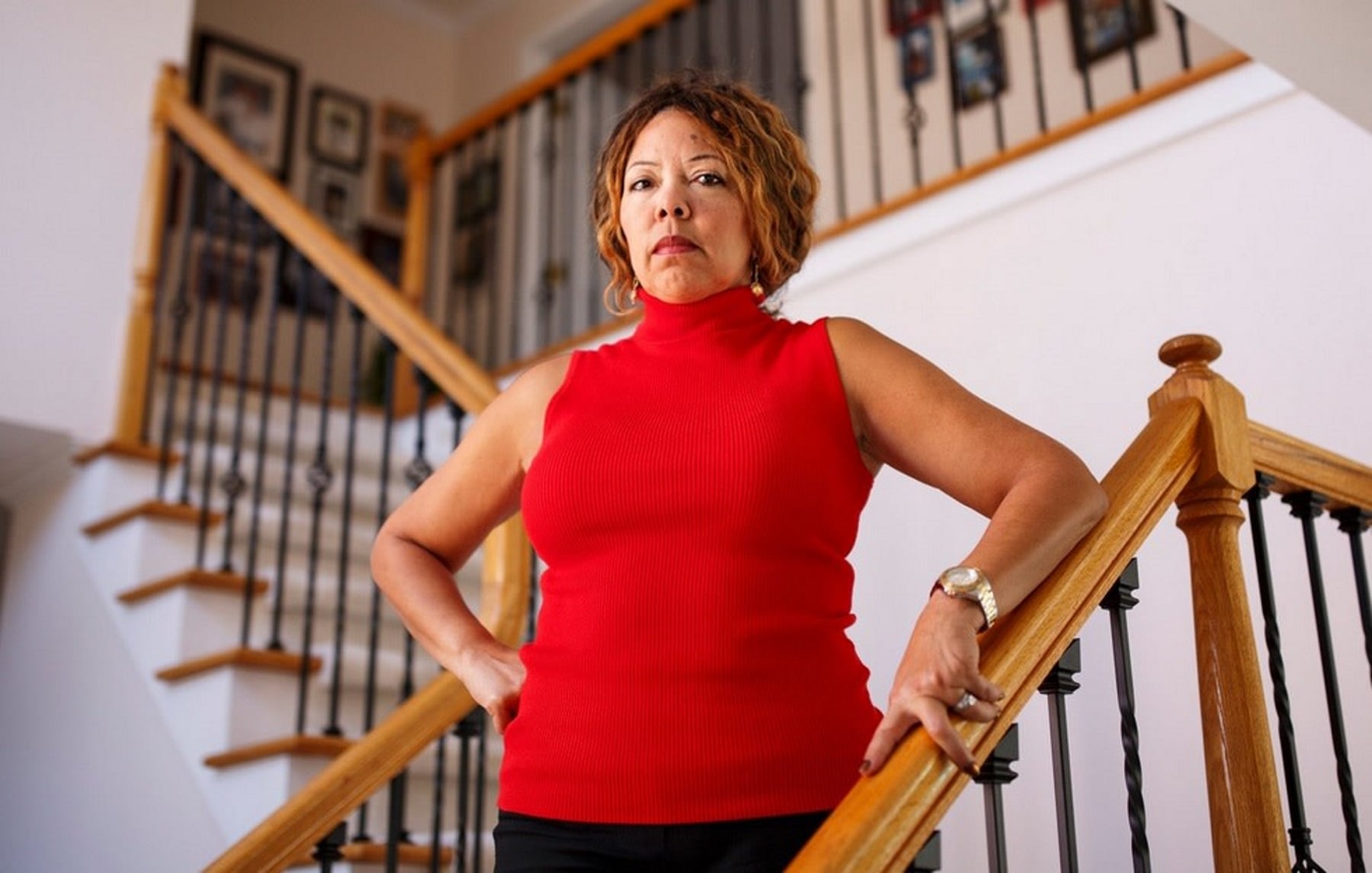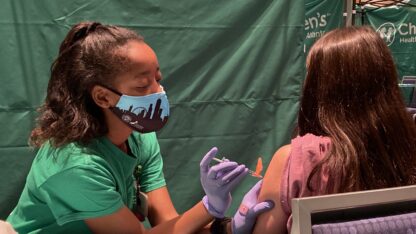Very different demographics
For an illustration, take a look at two Georgia counties that stand in stark contrast to each other, Dawson and Clayton. In the American Communities Project formula, Dawson is an exurb, while Clayton is defined as part of the African-American South. The latest Census reports that Dawson is roughly 91% white (non-Hispanic) and 1% Black. It is, even amid COVID-reduced traffic, an hour’s drive north of Atlanta, its giant outlet mall the last outpost of suburban sprawl before the landscape gives way to deep woods and tiny towns. Clayton is roughly 73% Black and 9% non-Hispanic white, is one of the cluster of counties adjacent to Atlanta, and home to Hartsfield-Jackson Atlanta International Airport.
If you zoom out to the dispassionate distance of data sets on a page, the two counties share some traits, but are also distinctly different. At just under 300,000 residents, Clayton is small and densely populated. Dawson is large and home to fewer than one-tenth the people, at just above 26,000. Both counties, like Georgia itself, have experienced double-digit population growth in the last decade. The two counties have roughly the same number of people per household, yet Dawson’s home ownership rate, just over 80%, far exceeds Clayton’s, which is less than half of all households. Though both counties have roughly the same percentage of adults who are high school graduates, Dawson’s residents have finished a four-year college degree at a rate approaching the national average, while Clayton’s residents are well below it. Just 8.8% of Dawson’s residents live in poverty; the figure is almost twice that in Clayton.
Dawson, home to father-and-son champion NASCAR drivers Bill and Chase Elliott, experiences 72 Deaths of Despair per 100,000 residents. Clayton, fictional home to Scarlett O’Hara’s Tara in “Gone With the Wind,” posts a rate of Deaths of Despair one third of that, 24 per 100,000 residents. Driving the difference? Dawson County — a place of rapid development, new roads, and growing employment — had the highest suicide rate of all Georgia’s 159 counties in the decade from 2010-2019. Through the frame of the ACP, Dawson is an outlier in that regard. Its age-adjusted suicide rate of 33 per 100,000, towers over the exurbs figure of 14 per 100,000.
I spoke with the chairman of Dawson County’s board of health, Dr. Larry Anderson, in his busy clinic on a hill overlooking a network of strip malls. “If you look out the window and go past those trees there, that’s the end of metro Atlanta. You are now in rural Georgia. So we’re out here on the fringe. The saying is, ‘It’s not how far you move away from Atlanta, it’s how many years are you away from Atlanta reaching you.’ So, Atlanta grows, it comes this way. When we moved here, the big box stores across the way in 2005, Walmart was not here, Home Depot was not here. If you look on the other side of our Premium Outlet Mall, nothing was there. And now it’s a huge development with Kroger on one side, Publix on the other, and we’re building back towards Atlanta instead of moving away.”
Dr. Anderson suggested there were realities hiding behind the statistics, of the human and physical geography of the place. For one thing, he suggested the per capita and household income statistics, as aggregations, hid the struggles of many of his neighbors. “because you’re dealing with, I think, earned money versus wealth that you bring.” Home value, he said, can send deceiving messages about family economic health.
Like so many people who live and work in Dawson, Dr. Anderson moved here from elsewhere. When he looks at the new built environment, he sees a society in transition, and one that is bound to have problems on the journey to setting down roots. He sees older people flocking to purpose-built communities, and young couples drawn from Atlanta by new jobs and low housing costs. A big subdivision may be full, but it might be a while before the new renters are really “neighbors,” and just a short time after that, they may be on the move again.
The quest to foster connection
Jill Mays, director of the Office of Behavioral Health Prevention at the Georgia Department of Behavioral Health and Developmental Disabilities (DBHDD), told me part of the state’s five-year strategy for driving the suicide rate down is fostering connection. “Part of that action plan addresses individual need for socialization and for feeling connected, and they actually map out steps like can we get you connected to a gym? Can we get you connected to a church? Can we get you connected to a recovery support group or a recovery community where you can, you know, work through that tendency to isolate, where you do get those connections . . . it’s kind of like the show ‘Cheers,’ you know the song, ‘sometimes you want to go where everybody knows your name.’ And that, that, it might be, you know, a cute song, but it’s really a great recovery principle; we all want people to know us and to accept us just as we are, and to understand that we’re not always OK, and that sometimes we will need help, and that there are people who are very willing to offer that help. So our peers play a powerful role in extending what we can do in terms of the clinical piece of suicide treatment.”
Neil Campbell, executive director of the Georgia Council on Substance Abuse, has watched with concern as the pandemic drove people apart, always risky for people fighting misuse of alcohol or drugs. “We often say the opposite of addiction is human connection, so when COVID hit and I saw places that were shut down, and my office shut down, we panicked but we also did a huge pivot toward online recovery meetings.” Moving the face-to-face sessions online took off. “We have thousands of people still to this day calling in to those meetings and we still have them twice a day, 10 o’clock and 7 o’clock in the evening. We started an LGBTQ meeting once a week, and we do two Spanish-speaking meetings a week because people were so lonely and so isolated . . . that isolation is immense.”
Training physicians to watch for signs
The sociologist Emile Durkheim pioneered the study of social connection and social ills, using the term “anomie” to describe a state of disconnection from the world of others around you. I thought of anomie again and again as Georgians talked to me about healthy relationships and connection, and the dangers of their absence. In a place like Dawson County, most people are not dangerously isolated and prone to self-destructive behavior. However, for those vulnerable to loneliness, depression and despair, and the toll they can take, you have to work to defeat the effects of geography to create connection.
Rachel Holloman, the DBHDD coordinator for Region 4, which includes Dawson County, says one of the first lines of defense in a place like Dawson, where men are unlikely to turn up at a care provider and volunteer that they are alone or sad, is to train physicians to watch more closely. “While they won’t necessarily use those words, there may also be physical aspects that a doctor can pick up on that can show that they are showing signs of anxiety or depression. Particularly when you talk about primary care physicians, family physicians, those physicians that see you on a regular basis. We find that men are a lot more likely to go into their primary care physician and admit there’s something going on, whether they address it as a mental health need or not, that can be one of those doors of access where we real easily catch what’s going on. And then we can also partner with primary care physicians to help reduce that stigma, to help them make the referrals, to help them open that door.
Georgia gets low grades from the United Health Foundation for its prevention of non-medical drug use, its provision of health insurance, and the overall access to care. United Health’s annual health rankings also conclude the state’s high incidence of avoiding health care due to cost and the prevalence of high-risk sexual behavior contribute to the numbers of lost years of life.
A coroner’s perspective
Just across the road from the complex that serves as Dawsonville’s City Hall, and the History Museum and Racing Hall of Fame, is a large funeral home operated by Ted Bearden. Bearden has seen a lot of death in his working life, as the operator of the funeral home and as the county’s elected coroner. In his business, and in his official capacity, he was busy as COVID burned through Dawson County, which suffered a death rate of some 132 per 100,000 population, roughly the exact rate of far more densely populated Clayton, well to the south. “Three-fourths of the people we were picking up were COVID-positive. My kids stopped me from going into hospitals and nursing homes. if I had to go out on a coroner’s case, there were cases that I worked where I never actually went in the house. If they were natural deaths, I had the family come to the porch, and I stood in the yard. Even when it kinda started to subside a little I’d knock on the door, and call inside ‘Is anybody in the house currently have COVID, are you aware of anybody in this house who’s been exposed to COVID? Has the deceased had COVID?’ If the answer was no, no, no, I’d say ‘OK, I’m gonna come in and talk to you, if all of you would move to the other side of the room.’ I never got an argument!”
Friendly, open, voluble, ready with a telling anecdote, Bearden has a unique vantage point for understanding the end of life in the community where he has lived all his life. Of a close friend who descended into depression and alcohol abuse after the death of a child he said, “He killed himself. He didn’t take a gun to his head or hang himself, but he killed himself. He was depressed, and he did not seek professional help, and he died. And I buried him. Sometimes it doesn’t say ‘suicide’ on a death certificate, but sometimes suicide can be a natural cause.”
As county coroner, Bearden said he rarely lists suicide as the cause of death in drug overdoses unless he can clearly establish intent, and that is rare. He is sure, he said, that many of the people who die from overdoses did not mean to take their own lives, but instead run afoul of the body’s tendency to need more and more of some widely used drugs to achieve the same effect. Drug interactions, and the tendencies of some drugs to exacerbate the effects of others, he said, leads to people dying when all they wanted was an escape from the day’s problems.
In past years, Dawson has had flare-ups of teen suicide. For older people, Bearden cited familiar stressors — marital breakups, financial crises, medical problems. None of those were present with the unusual number of high schoolers who were taking their own lives. Social and relationship problems so overwhelmed them in some cases, Bearden said, they resorted to “like the old saying goes, a permanent solution to a short-term problem.” Faced with the challenge of suicides and attempted suicides, the high school finally instituted education, outreach, and early warning and detection policies, which seem to be working.
People who don’t ask for help
In Clayton County, all the difficulties of daily life are just as present. Teenage boys and girls pair up and break up. Couples head for divorce court. Working people face long-term financial hardship. Yet the Deaths of Despair in Clayton are a fraction of those detected in Dawson. Indeed, Clayton’s Deaths of Despair rate is even low compared to the communities of the African American South overall, 22.5 per 100,000 versus 39 per 100,000. Why? People in Clayton were not aware of the numbers, but they were not surprised by them.
At the same time, the vast difference between Black and white Georgians in this regard was not that easy to explain. Karen Daniels is an activist and former addict who now works in rehabilitation and prevention in Clayton County. She thought about the much lower suicide rate in Clayton and searched for an answer. “The fact is it [suicide] hasn’t been a part of our culture.” At the same time as relatively fewer people end their own lives, there is persistent drug abuse. “We find another way, anything thing to take us away, but it doesn’t kill us.
“You don’t ask for help. Keep it in the family. We’re not gonna get any kind of mental health services because that’s kind of frowned on in families. We’re gonna pray you through this.”
Luvenia Jackson, a member of the Clayton County Health Board, and a longtime school administrator, agrees that this aspect of Black culture developed in an era of persistent government neglect. Self-reliance did not necessarily develop as a virtue, but instead in response to the low expectation that anyone was coming to help. “Given that kind of upbringing, or socialization, people are brought up that you’ve got to take care of yourself.
“People are brought up, you gotta take care of yourself. Don’t trust the police. Don’t trust mental health officials, those kinds of things. You end up thinking you’ve got to take care of yourself. You’ve got to make it. You just gotta make it, you don’t show mental health issues. You work it out.”
Daniels’ observation made sense. At the same time, it was the exact opposite of the messages coming from the state, urging people struggling with depression, substance abuse, or suicidal ideation to come forward for care, counseling, and treatment. That old ethic of sucking it up and soldiering on might get you through a few rough days or weeks, but when it does not work the consequences can be deadly.
Jill Mays, who is African-American, is trying to develop strategies for reaching men in trouble who might not otherwise seek help. “Men will open up and talk in a barber shop about things that they may not talk about at home with their wife, they may not talk about, you know, at work, but they’ll talk to their barber and the other guys sitting around, so our thinking is if we can train the barbers to have that conversation and to make the referral, it kind of normalizes help-seeking for men. And it’s not just men. There are minority groups across the state who have that same thing that they were taught, you know, you don’t talk about our family problems or your personal problems outside of the house. You know, it, you appear weak if you ask for help. So try to combat that stigma in all areas where it’s impacting people being willing to ask for help.”
Pride and respect
Jeffrey Turner came to elected office as the chairman of Clayton’s Board of Commissioners after a long tenure as the county’s chief of police. He rose to command after joining the force as one of the first black patrolmen in the county. After spending years emphasizing enforcement as a response to drug use, he now has to see the problem from an entirely different position, as he fights for more funding from the state for diversion, rehabilitation, and access to mental health services. He is also the chairman of the county’s board of health. Off the top of his head, he can paint a vivid demographic portrait of his county’s people: younger than other Georgians, more likely to live in a female-headed household, more likely to move and change jobs frequently.
Yet when I laid out the differences in Deaths of Despair between Dawson and Clayton counties, he got personal. “We are taught at a very, very young age to be men, you always have to fight, and go beyond what’s expected of you. Because we have been suppressed, depressed, we have been held back, we have always had to be ten times better than white males or others to prove ourselves.
“So there’s a sense of pride there and I know for me personally, suicide or trying to hurt myself or others never entered the equation. Simply because I was always taught to respect somebody but also to have self-pride.
“A lot of Black men that I have dealt with have that similar upbringing.”
Firearm ownership
Dr. Jonathan Metzl, a Missouri psychiatrist, has been looking closely at the differences between rates of early deaths of different kinds of Americans. The author of “Dying of Whiteness,” Metzl has conducted hundreds of interviews and focus groups to assess the attitudes and personal choices of different Americans, their relationship to the health care system, governments and aid programs. He has observed that these attitudes come bundled, not one-by-one. If you were anti-mask and anti-vaccine, it was more likely you were also against any restrictions on gun ownership, and against the Affordable Care Act.
Almost two out of three suicides in Georgia are accomplished using firearms. The typical Georgia household is more likely to have a firearm than the typical American household. The difference would likely be even greater if not for the state’s large black, Latino, and Asian populations, which are all less likely to own a firearm. I asked Dawson’s Anderson about an office consultation during which a patient told him he had thought of committing suicide. Would he ask that patient if there was a firearm in the house, knowing of the correlation between firearm ownership and accidental and intentional deaths by firearm? No, he would not. “Why should I plant an idea into your head if you’re thinking of suicide? Oh, let me tell you the best way to do it!” A physician, but also a veteran, and the holder of a concealed carry permit, Anderson defended their legal right and their hobby: that people use other means to commit suicide, that cars kill people but nobody suggests banning cars, that restricting the availability of firearms would not end suicide.
Worries about guns
The states with the highest percentage of white population are also the states with the highest levels of gun ownership. Almost none of the states with the highest percentage of gun-owning households are in the Northeast and Midwest. Why would the pandemic change the picture? Because, Metzl said, the pressures are there to shift gun ownership away from a white racial script. “There’s so much anxiety, I mean, if you think about it, just talking to a stranger is a mortal risk, because they could give you the coronavirus, and there’s so much mistrust and this breakdown of governance, and so this marketing now about, you know, the police aren’t going to protect you, so arm yourselves, and things like that, it has a different and very real valence during a pandemic.
“And we’ve seen millions and millions of guns sold. And so, I can tell you that the experience before the pandemic of white America with guns is one that unregulated gun sales lead to feelings of power and privilege on one hand, and dramatically rising rates of all kinds of gun death, suicide, partner violence, accidental shooting on the other.
“And I worry that that’s going to become an American story, not just a white America story given just the ways that guns have been sold in this pandemic.”
The numbers bear out Dr. Metzl’s fears. The National Instant Criminal Background Check System reports nearly 40 million guns were purchased during 2021. The Journal of the American Medical Association published research from UC Davis’ Violence Prevention Program that suggested an intersection between concerns about rising crime, rising psychological distress driven by the pandemic, and fear of widespread unrest like that seen across the country had encouraged more people to buy guns.
Data guide response
Unlike statistics around infections, hospitalizations, and deaths, the impact of a change in attitudes toward firearms will be harder to measure, and of much longer duration. It is important to note that while violent crime has risen recently, the number of guns purchased in the U.S. has risen steadily most years since the end of the last century, and through most of that period violent crime in the country declined.
Anderson, skeptical of physician attempts to assess gun ownership among those at risk for suicide, supports primary care physicians and other high contact medical professionals being more careful about watching for signs of depression and suicidal ideation. Press too hard on follow-ups about guns, he suggests, and people would simply lie, as he said men did when firearms-related questions became standard at VA hospitals, “and so if you asked them questions like that, the answer was always no.”
Jill Mays said Georgia will base its responses to early death based on data. She said Georgia has been able to respond to a recent rise in suicide among adolescent girls, just as it responded with assessment, information, and follow-up to the discovery that suicide risks were elevated for veterinarians. That is how fine-grained the data has been. “We’ve though, we’ve planned out, and we can tell you here’s the top five things that we need. So we’re ready with the answer when the funding comes down.”
Ray Suarez is co-host of the public radio program and podcast World Affairs, and covers Washington for Euronews. He is the author of three books on American life, most recently Latino Americans: The 500-Year Legacy That Shaped a Nation.
The American Communities Project, with funding from the Arthur M. Blank Family Foundations, explores Deaths of Despair through the lens of 15 community types. Georgia Health News is a media partner for the series.









